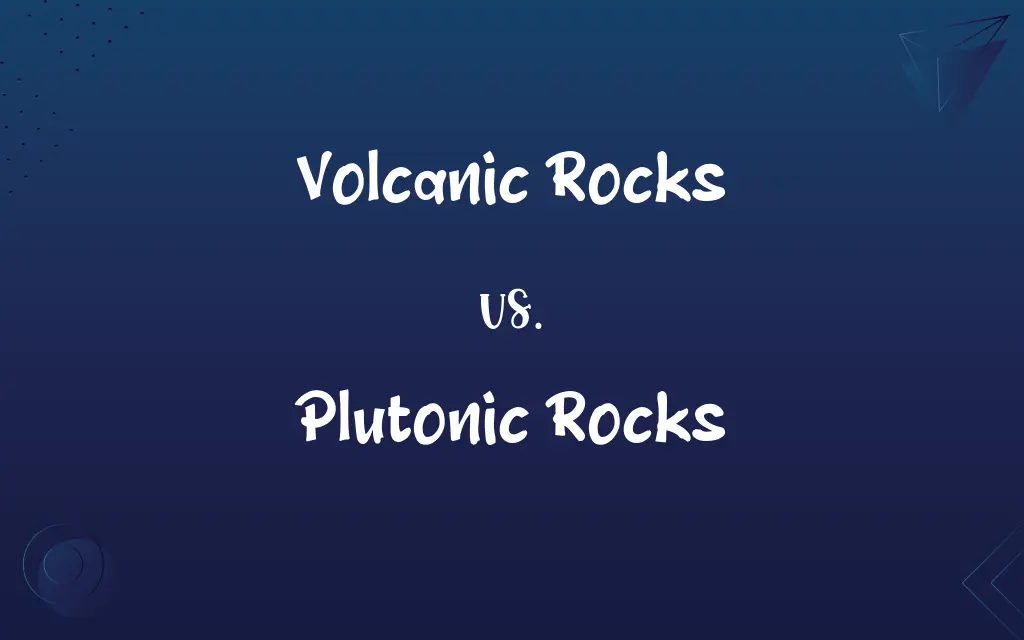Volcanic Rocks vs. Plutonic Rocks: Know the Difference

By Shumaila Saeed || Published on February 16, 2024
Volcanic rocks form from lava at the Earth's surface, cooling quickly, while plutonic rocks form deep underground from slowly cooled magma.

Key Differences
Volcanic rocks, also known as extrusive igneous rocks, are formed from lava that has erupted onto the Earth's surface and cooled rapidly. This rapid cooling often results in fine-grained textures. In contrast, plutonic rocks (or intrusive igneous rocks) form from magma that cools and solidifies slowly beneath the Earth's surface, typically resulting in a coarse-grained texture.
Shumaila Saeed
Feb 16, 2024
The texture of volcanic rocks is usually fine-grained or glassy due to the quick cooling of lava exposed to the surface environment. This rapid solidification often traps small gas bubbles, creating vesicular textures. On the other hand, plutonic rocks have a distinctly coarse-grained texture because the slow cooling process underground allows large crystals to form. These rocks are often homogeneous and dense.
Shumaila Saeed
Feb 16, 2024
Examples of volcanic rocks include basalt and rhyolite, which are commonly found in areas with volcanic activity. These rocks can display a variety of colors and compositions, depending on the minerals present in the lava. Plutonic rocks, like granite and gabbro, are typically found in regions with historical volcanic activity but formed deep within the Earth, often exposed by erosion or tectonic processes.
Shumaila Saeed
Feb 16, 2024
In volcanic rocks, the mineral composition can vary widely, but they often contain minerals like olivine, pyroxene, and feldspar. The rapid cooling can sometimes result in a glassy matrix without distinct mineral grains. Plutonic rocks generally consist of minerals like quartz, feldspar, and mica, which are visible to the naked eye due to the slow crystallization process.
Shumaila Saeed
Feb 16, 2024
Volcanic rocks play a significant role in shaping landscapes and are often associated with volcanic islands and mountain ranges. They also contribute to soil fertility in many regions. Plutonic rocks form the foundation of continental crust and are extensively used in construction and as decorative stones due to their durability and aesthetic appeal.
Shumaila Saeed
Feb 16, 2024
ADVERTISEMENT
Comparison Chart
Formation Process
Cooled from lava on Earth's surface
Cooled from magma beneath Earth's surface
Shumaila Saeed
Feb 16, 2024
ADVERTISEMENT
Volcanic Rocks and Plutonic Rocks Definitions
Volcanic Rocks
Volcanic rocks form from the rapid cooling of lava on the Earth's surface.
Basalt, a common volcanic rock, is often found in oceanic islands.
Shumaila Saeed
Jan 17, 2024
Plutonic Rocks
Plutonic rocks are characterized by their coarse-grained texture.
The large crystals in granite are a result of its plutonic origin.
Shumaila Saeed
Jan 17, 2024
Volcanic Rocks
Volcanic rocks are characterized by fine-grained or glassy textures.
Obsidian, a volcanic rock, has a smooth glassy surface.
Shumaila Saeed
Jan 17, 2024
Plutonic Rocks
Plutonic rocks form from the slow cooling of magma beneath the Earth's surface.
Granite, a widely used plutonic rock, forms the core of many continental regions.
Shumaila Saeed
Jan 17, 2024
Volcanic Rocks
Volcanic rocks are common in areas of current or past volcanic activity.
The Hawaiian Islands are composed primarily of volcanic rocks.
Shumaila Saeed
Jan 17, 2024
ADVERTISEMENT
Plutonic Rocks
Plutonic rocks are used extensively in construction and decoration.
Granite is a popular choice for countertops due to its plutonic durability.
Shumaila Saeed
Jan 17, 2024
Volcanic Rocks
Volcanic rocks often contribute to soil fertility in volcanic regions.
The rich soils in volcanic areas are due to the weathering of volcanic rocks.
Shumaila Saeed
Jan 17, 2024
Plutonic Rocks
Plutonic rocks are often exposed by erosion or tectonic activity.
The granite cliffs in Yosemite National Park are exposed plutonic rocks.
Shumaila Saeed
Jan 17, 2024
Volcanic Rocks
Volcanic rocks can have vesicular textures due to trapped gas bubbles.
Pumice, a type of volcanic rock, is so light that it can float on water.
Shumaila Saeed
Jan 17, 2024
Plutonic Rocks
Plutonic rocks form the foundation of the continental crust.
Continental landmasses are underlain by massive plutonic rock formations.
Shumaila Saeed
Jan 17, 2024
Repeatedly Asked Queries
What are volcanic rocks?
Rocks formed from the rapid cooling of lava at the Earth's surface.
Shumaila Saeed
Feb 16, 2024
Can volcanic rocks form large crystals?
Generally, no, due to their rapid cooling rate.
Shumaila Saeed
Feb 16, 2024
Are plutonic rocks visible at the Earth's surface?
They become visible after erosion or tectonic uplift exposes them.
Shumaila Saeed
Feb 16, 2024
Where are volcanic rocks commonly found?
In areas with current or past volcanic activity, like islands and mountain ranges.
Shumaila Saeed
Feb 16, 2024
How are plutonic rocks formed?
By the slow cooling and crystallization of magma deep within the Earth.
Shumaila Saeed
Feb 16, 2024
What texture do plutonic rocks typically have?
Coarse-grained texture with visible crystals.
Shumaila Saeed
Feb 16, 2024
What texture do volcanic rocks typically have?
Fine-grained or glassy texture.
Shumaila Saeed
Feb 16, 2024
What are plutonic rocks?
Rocks formed from the slow cooling of magma beneath the Earth's surface.
Shumaila Saeed
Feb 16, 2024
What minerals are commonly found in volcanic rocks?
Minerals like olivine, pyroxene, and feldspar.
Shumaila Saeed
Feb 16, 2024
How are volcanic rocks formed?
By the rapid cooling and solidification of lava during volcanic eruptions.
Shumaila Saeed
Feb 16, 2024
Can plutonic rocks form mountains?
Yes, exposed plutonic rocks can form mountain ranges.
Shumaila Saeed
Feb 16, 2024
What minerals are commonly found in plutonic rocks?
Minerals such as quartz, feldspar, and mica.
Shumaila Saeed
Feb 16, 2024
Are volcanic rocks important for agriculture?
Yes, they often contribute to fertile soils in volcanic regions.
Shumaila Saeed
Feb 16, 2024
What are some uses of plutonic rocks?
They are used in construction, as decorative stones, and for countertops.
Shumaila Saeed
Feb 16, 2024
Do volcanic rocks form underwater?
Yes, many volcanic rocks form from underwater eruptions.
Shumaila Saeed
Feb 16, 2024
How do volcanic and plutonic rocks contribute to Earth's geology?
They provide insights into Earth's volcanic activity and internal processes.
Shumaila Saeed
Feb 16, 2024
Where are plutonic rocks commonly found?
In regions with historical volcanic activity, now exposed by geological processes.
Shumaila Saeed
Feb 16, 2024
Share this page
Link for your blog / website
HTML
Link to share via messenger
About Author
Written by
Shumaila SaeedShumaila Saeed, an expert content creator with 6 years of experience, specializes in distilling complex topics into easily digestible comparisons, shining a light on the nuances that both inform and educate readers with clarity and accuracy.








































































